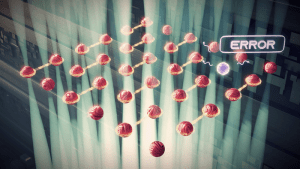Could a New System of “Erasure Error” be Key to Quantum Error Correction?
One of the biggest challenges in developing a quantum computer is error correction. Errors within quantum computing are quite common, mainly due to environmental noise and the overall fragility of the system. These errors can cause inaccurate measurements and skew the outcomes of quantum programming. Many companies, like IBM and Google, are working on ways to correct these errors or recalibrate quantum computers to be more error-proof. In a new paper from Nature Communications, a team from Princeton University offers an alternative method to error correction by looking at a system known as “erasure error.”

Researchers from Princeton University developed a system called erasure error, which can withstand a higher number of errors in a quantum computer. (PC GABRIELE MEILIKHOV/MUZA PRODUCTIONS)
What is Quantum Error Correction (QEC)?
Because qubits, the core units of a quantum computer, are quite fragile, they are susceptible to errors. “The central problem now in quantum computing is getting enough high-fidelity qubits to implement quantum error correction,” explained Jeffrey Thompson, an associate professor at Princeton University and the lead researcher on the study in an interview with Inside Quantum Technology. For most types of quantum error correction (QEC), an algorithm is used to identify and mend errors within the quantum computer. While these algorithms are based on mathematical approaches, they are far from perfect. As Thompson explained: “In standard quantum error correction, you have to determine both the locations and types of errors that occurred on your qubits, from a limited set of observations, known as syndrome measurements.” While these syndrome measurements are helpful in pinpointing errors, they do not always lead to successful error correction. “Error correction fails when you do not have sufficient information to make these determinations unambiguously, which occurs when there are too many errors,” Thompson added.
Finding Erasure Error
Instead of fixing this problem by reducing the total number of errors, Thompson and his team worked to make the errors easier to identify. They found this almost by accident while studying the structure of the ytterbium qubit. The two electrons in the ytterbium’s outer shell seemed t be key in helping with error correction. Diving into the physical causes of the error, the researchers were able to develop a system where the source of the error erases or eliminates, the inaccurate data. The erasure system worked by linking the quantum errors to the energy shift in the outer electrons. Thompson calls this particular system an “erasure error, ” and it can help show where data is inaccurate. “An ‘erasure’ error is a special type of ever that reveals its own location, so you can use more of the syndrome information to figure out the error type,” Thompson said. “This allows you to handle more errors, and therefore increase the performance of error correction.” Erasure errors are rather common in classical computing but are only now considered in quantum computing.
Using erasure errors, the researchers found their new technique could withstand a 4.1% error rate, which is feasible for current quantum computers. Previous systems could only withstand an error rate of 1% before being overwhelmed with a higher percentage of error. Thompson believes that this higher percentage can make a bigger quantum computer with more qubits a likely reality. “If you have qubits that are biased toward erasure errors, you don’t need as many, and they can perform worse,” added Thompson. “For certain ranges of parameters, erasure-biased qubits might require 10 x or even 100x fewer qubits to achieve a certain level of QEC performances compared to conventional qubits.” For many companies looking to scale up their quantum computers, an erasure error system may be key to achieving these goals. “It may be possible to subtly redesign existing qubits to achieve this,” said Thompson. “There’s a lot of interest in this idea.”
Kenna Hughes-Castleberry is a staff writer at Inside Quantum Technology and the Science Communicator at JILA (a partnership between the University of Colorado Boulder and NIST). Her writing beats include deep tech, the metaverse, and quantum technology. You can find more of her work at her website: https://kennacastleberry.com/















